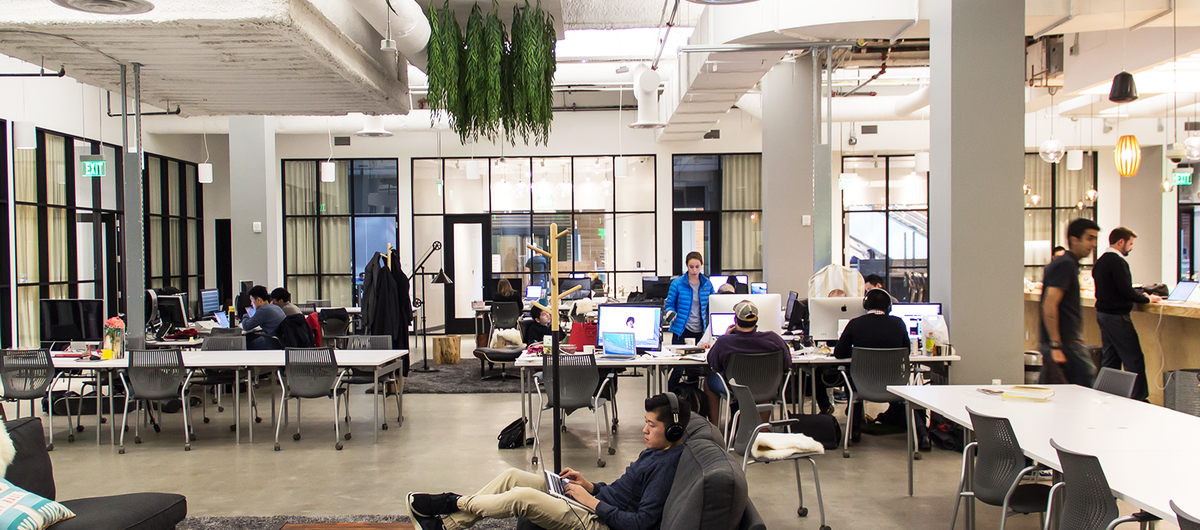Operators Taking Shopping Mall Space
On the flipside, we see independant coworking spaces signing leases with shopping centers. Dogpatch Labs is a start-up hub centrally located in Dublin’s digital docklands and is CHQ’s largest tenant. The 1820s shopping center lets space to interesting tenants including the EPIC Museum, is close to the rail station and surrounded by likes of LinkedIn, Facebook and more.
Located across the first 3 floors of CHQ, Membership Manager Jake Phillips states Dogpatch benefits from “being a touch point for well over 8,000 people walking past every day. We built the retail location as a strategic mechanism to deliver our brand values of community and innovation. We are also involved with corporate initiatives; CHQ recently supported Mastercard with their app pilot focusing on the city’s demographic spending data. Being situated in a retail environment means we can also deliver a live storefront.”
Given the historic protection of the converted wine and tobacco warehouse as a Grade A listed building, the fit out costs for Dogpatch were more expensive than a non-retail space. However, the company has seen high returns as a result of the investment. Jake explains how “the investment pays when focus is on design. We built a strong relationship with the landlord through a co-branded building strategy to become a unified, authentic Irish brand and top 10 tourist destination. This journey involved strategic partnerships such as those with Google for Entrepreneurs, community involvement through local food discounts and weekly metric reports.”
Renting space from a shopping center can be a challenge in terms of opening hours beyond the operators control. Dogpatch have many software development teams working early and late hours, but thanks to their strong relationship with the landlord, they’re able to make alternative arrangements for their own operating hours. Dogpatch is also surrounded by alternative laptop hotspots, but with local farmer-grown coffee and a strong ecosystem, member applications aren’t affected. Dogpatch’s typical members include corporates seeking to innovate and start-ups seeking post seed or angel investment to Series A.
Like many spaces, private offices are Dogpatch’s most popular membership type, but Jake emphasises that “the private offices are golden; we reserve and allocate them selectively to growing members. The private offices aren’t listed on our website as we don’t want to be seen as an ‘office solution’. Most of our small teams work from dedicated desks in open space.”
The Verdict
Whether the coworking space is landlord or operator ran, there are a few key ingredients for success: community-based ecosystems as opposed to office solutions, partnerships with retail-tech startups and corporates, utilization of the retail environment for product testing, investment in design and flexibility and a criteria for member selection.
Key benefits include close proximity to leisure facilities, strong transport links and parking space, position at the forefront of retail innovation, extra visibility for increased footfall and popular uptake of private office memberships. The main challenges for operators include lack of control over building operations, potential lack of daylight and opening hours, along with frequent positioning in remaining space on higher floors. The main challenge for shopping center owners is the decision to share revenue by letting space to an operator or launch their own coworking brand as a new entrant to the workspace market.
What Does the Future Look Like?
Given the optimism around coworking within shopping centers, it’s no surprise that CBRE predict shopping centers to reinvent themselves as mixed-use ‘Centers’ by 2030. Who will be the first to get there? Western Australia is particularly active as a leading region for the lifestyle revolution of shopping centers. The Government’s ‘Direction 2031’ removes limitations on the size of retail developments and encourages the development of ‘activity centers’.
The future of coworking within shopping centers is described by Kimiko Thornton as a ‘no-brainer’: “As the retail ecosystem evolves, consumers expect dynamic experiences beyond the traditional storefront. Coworking ultimately contributes to the restructuring of the entire experiential landscape. It’s a trend shopping centers are exploring at a global level.”







